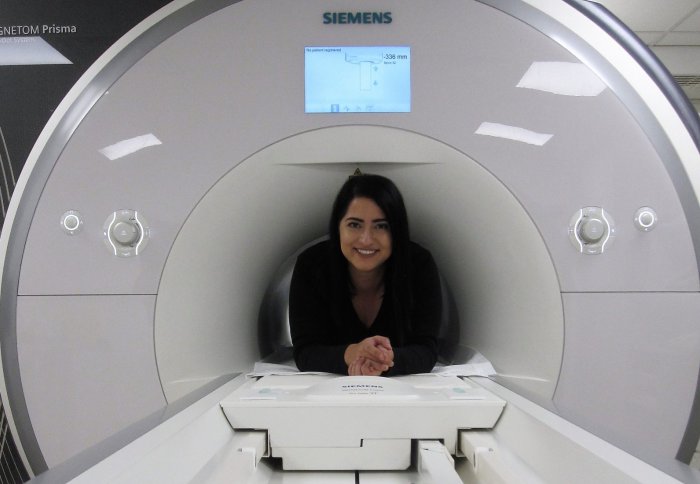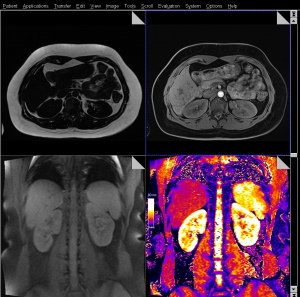
Saba in the Robert Steiner MRI Suite at Hammersmith Hospital

European student, Saba Shirvani, came to Imperial from Vienna last year to study the MRes in Bioimaging Sciences. Here she reflects on her experience.
Hi Saba! Why did you choose to study at Imperial?
Before I decided on Imperial I visited the head of the programme to find out more about the course; this conversation really cemented my desire and motivated me to pursue a postgraduate degree at Imperial. The course offers a taught component and a research project, which allows you to see what it’s actually like to work in the field. I read up on Imperial’s research impact – there are so many high quality papers published from different labs here, I just knew that this was a community I wanted to be involved in. Additionally, I was based in the Robert Steiner MRI suite at Hammersmith Hospital, which not only offers an amazing facility, but also the newest 3T Siemens Magnetom MR Scanner.
What does the bioimaging science degree involve?

Structural Scans of the kidneys
During the taught component of the course you study a variety of different imaging modalities used in medicine and research, such as ultrasound, magnetic resonance imaging (MRI), Positron Emission Tomography (PET) and Single-Photon Emission Computed Tomography (SPECT). You also get the chance to explore aspects of radiopharmacology in imaging, contrast agents and image computation.
From there you develop a personal project in line with your specific interests. My project applied MRI imaging with a new technique called arterial spin labelling to image kidneys and measure perfusion. There are only a handful of studies that show perfusion quantification in the kidneys, as it’s mainly a technique used on the brain, so it’s a whole field waiting to be explored.
Why does this area of research appeal to you?
MRI requires knowledge of varied subject areas. Physics helps to understand how the MRI works; computations apply when studying the images and finding out statistical values; we explore applications in programming, so it’s very diverse. It’s not just the imaging part that’s interesting, but the whole process – how did you get to that image and how does the process impact its resolution and quality?
There’s this misconception of engineering and imaging being very conservative and this is absolutely not the case at Imperial, or in the UK in general. It’s such a promising, inclusive, exciting field – I encourage anyone with an interest to find out more no matter their background.
What’s your favourite thing about studying in London?
I absolutely love London! I love the diversity – people from so many parts of the world and different backgrounds. The food and cultural aspects are brilliant too; I’ve been here for a year and there’s still so much more to explore!
What advice would you give to new students?
Before you start this kind of degree it’s really helpful to get some work experience in lab facilities. Even a short internship of a couple of weeks gives you a sense of what's involved and expected professionally in this field, and in my experience labs are very open to taking on interns who are interested in imaging.

What’s your most significant memory of your time at Imperial?
The final presentation of my research project at the annual departmental MRes conference. I was nervous that the technical aspects of my MRI research study might not seem so appealing to a broader audience, but in the end I won first prize for the Master of Research course Conference 2016-17, which was a great moment – all the hard work had paid off! It’s great to get that kind of feedback from the department, to feel like you’re going in a positive direction.
What was your experience of being a European student in the UK?
Before you begin it can be a bit scary, but once you get here and your programme starts you meet friends, course colleagues, supervisors and have loads of opportunities to get involved. Imperial offers a strong community. The union is in regular contact with students, highlighting all kinds of opportunities, like the student hub and societies, which are a great way to meet people – you’re not left to figure out things all by yourself. It’s very welcoming and open; you just have to make that first step and then everything else stems from there.
What’s the plan now?
For now I’ll stay in academia and continue working in the research lab. Long-term I’d definitely like to pursue a PhD.
This has been a great year of my life, and a big milestone. I’m really proud of the work I’ve put in to get the research done in such a short amount of time. My supervisors have been brilliant; they really support you to evolve and progress; I wanted to try and learn as much as I could from them. They had a great impact on my studies because they were incredibly helpful and patient, but also gave me a lot of independence to work things out for myself, so I had the space to absorb the research in my own time. Imperial is an amazing university and I’m so happy that I made the big decision to come here and join this scientific community.
Article text (excluding photos or graphics) available under an Attribution-NonCommercial-ShareAlike Creative Commons license.
Photos and graphics subject to third party copyright used with permission or © Imperial College London.
Reporter
Claudia Cannon
The Grantham Institute for Climate Change

Contact details
Email: c.cannon@imperial.ac.uk
Show all stories by this author



